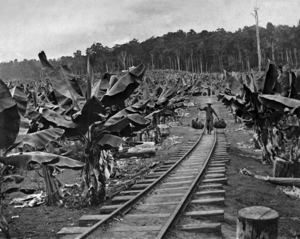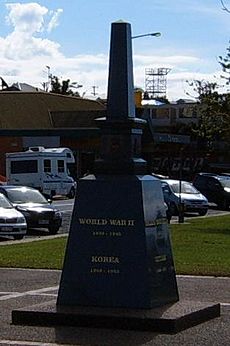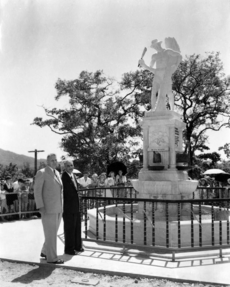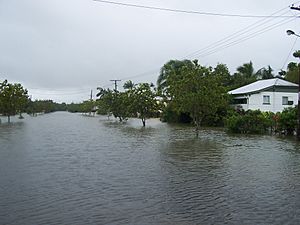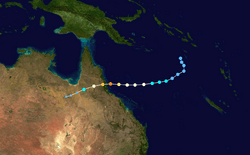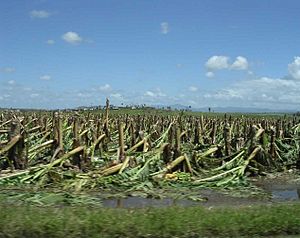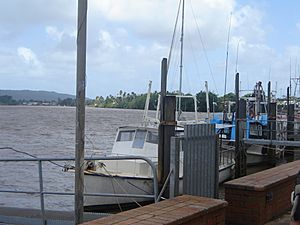Innisfail, Queensland facts for kids
Quick facts for kids InnisfailQueensland |
|||||||||||||||
|---|---|---|---|---|---|---|---|---|---|---|---|---|---|---|---|
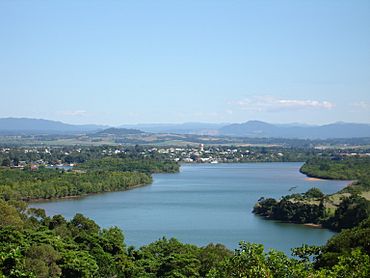
The township of Innisfail, as seen from Coquette Point
|
|||||||||||||||
| Population |
|
||||||||||||||
| • Density | 703/km2 (1,820/sq mi) | ||||||||||||||
| Established | 1882/83 | ||||||||||||||
| Postcode(s) | 4860 | ||||||||||||||
| Elevation | 10 m (33 ft) | ||||||||||||||
| Area | 10.3 km2 (4.0 sq mi) | ||||||||||||||
| Time zone | AEST (UTC+10:00) | ||||||||||||||
| Location |
|
||||||||||||||
| LGA(s) | Cassowary Coast Region | ||||||||||||||
| State electorate(s) | Hill | ||||||||||||||
| Federal Division(s) | Kennedy | ||||||||||||||
|
|||||||||||||||
|
|||||||||||||||
Innisfail (from Irish: Inis Fáil) is a regional town and locality in the Cassowary Coast Region, Queensland, Australia. The town was originally called Geraldton until 1910. In the 2016 census, the town of Innisfail had a population of 7,236 people, while the locality of Innisfail had a population of 1,145 people.
Innisfail is the major township of the Cassowary Coast Region and is known for its sugar and banana industries, as well as for being one of Australia's wettest towns. In March 2006, Innisfail gained worldwide attention when severe Tropical Cyclone Larry passed over causing extensive damage.
Contents
History
Prior to European settlement the Innisfail area was occupied by five separate societies of the Mamu people. These Aboriginal people followed migratory lifestyles in the rainforest and traversed rivers in string-bark canoes.
The first arrival of European people came in 1872 when survivors of the shipwreck, the "Maria" arrived on the coastal areas surrounding what is now the Johnstone River. Sub-Inspector Robert Arthur Johnstone's search party came with the intention of rescuing remaining survivors. The crew would later venture up river between what is today Flying Fish Point and Coquette Point. Johnstone wrote very highly of the area, stating:
A most glorious view appeared - a noble reach of fresh water, studded with blacks with their canoes and catamarans, others on the sandy beaches; deep blue fresh water expanding to an imposing breadth.
—Robert Johnstone (1872)
Johnstone named the area after himself and upon his recommendation the explorer George Elphinstone Dalrymple arrived in the area in September 1873 to chart the area further.
Later in 1879, Irishman Thomas Henry FitzGerald arrived in the area to establish a sugar industry. He was accompanied by large numbers of Kanaka South Sea Islanders workers accompanied by smaller numbers of Irish labourers. The house built by FitzGerald and thus the first establishment in the area was called Innisfallen, after the largest island in the Lakes of Killarney, Ireland. Inis Fáil (Island of Destiny) is an ancient Irish name for Ireland itself. The name is used in the rarely-sung third verse of "The Soldier's Song", the Irish national anthem. The stone mentioned may be the stone at Tara, Co Meath, at which high kings of Ireland were crowned.
From 1879, the settlement was named Geraldton after FitzGerald, but in 1910 was renamed "Innisfail" to avoid confusion with the town of the same name in Western Australia.
Johnstone River Post Office opened on 1 November 1882 (a receiving office had been open from 1880), was renamed Geraldton two months later and Innisfail in 1910.
In 1906 Patrick Leahy established the Johnstone River Advocate newspaper. Later it was renamed the Johnstone River Advocate and Innisfail News, the Evening Advocate, and the Innisfail Chronicle. The newspaper continues to be published as the Innisfail Advocate.
The 1920s and 1930s saw the beginning of a major period of settlement by Italian immigrants and noteworthy populations from Greece and Malta. Later in this period populations from Yugoslavia, India and the Philippines would also settle in the area.
Local rugby league footballer Kerry Boustead was the only player from outside the Sydney and Brisbane Leagues selected to represent Australia on the 1978 Kangaroo tour.
The Innisfail War Memorial in Jack Fossey Park on Fitzgerald Esplanade was dedicated on 16 April 2005; it commemorates those who served in all wars.
In the 2006 census, Innisfail had a population of 8,262 people.
Today the town still boasts many good examples of the Art Deco and Streamline Moderne styles of architecture.
Heritage listings
Innisfail has a number of heritage-listed sites, including:
- 10 Edith Street: Innisfail Courthouse
- 134 Edith Street: See Poy House
- Fitzgerald Esplanade: Canecutters Memorial
- 70 Rankin Street: Johnstone Shire Hall
- 90 Rankin Street: Mother of Good Counsel Catholic Church
- 114 Rankin Street: St Andrew's Presbyterian Memorial Church
Culture
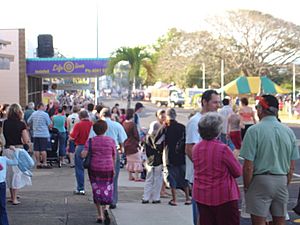
Today Innisfail remains incredibly multicultural, with prominent populations of indigenous Australians, Europeans (in particular Italians), Indians and East Asians (in particular Hmongs).
A number of events take place annually to celebrate the cultural diversity within the Innisfail community:
- Kulture Karnival
- Festival Innisfail
- Feast of the Senses
- Feast of the Three Saints
Such events are extremely popular among residents and attract good turnouts.
In 2001 Los Angeles band Sugar Ray filmed part of their music DVD "Music in High Places" at the Johnstone Crocodile Farm in Innisfail.
Being a small community, and one that was recently subjected to a severe natural disaster Innisfail harbours a definite sense of community. The township has only 2 secondary schools: Good Counsel College and Innisfail State College and a single business district.
There are many events that act predominantly as community events, the main ones include:
- The Innisfail Rodeo
- Harvest Festival
- Annual Show
While Innisfail was always reputed to have a positive sense of community spirit, the aftermath of Tropical Cyclone Larry and the unified cleanup effort acted to promote this spirit through shared suffering.
Religion
In the past Chinese Australians built the Innisfail Temple/Lit Sing Gung (列聖宮). It was originally a Chinese temple, but nowadays the building is open for rituals of every race and religion. The temple is located at Owen Street.[1] Home to many Italian residents.
Geography
Innisfail's town centre is situated at the junction of the North and South Johnstone Rivers, approximately 5 km (3 mi) from the coast. It is located near large tracts of old-growth tropical rainforest surrounded by vast areas of extensive farmlands. Queensland's highest mountain, Mount Bartle Frere; part of Australia's Great Dividing Range, is 15 kilometres (9 mi) to the north.
Climate
Innisfail experiences a tropical rainforest climate (Köppen climate classification Af) as it has no month with a mean temperature below 18 °C (64.4 °F) or with less than 60 millimetres (2.4 in) of rainfall. Consistently, humid, very warm to hot weather dominates in Innisfail. In particular Innisfail is reputed as being among the wettest towns in Australia. Babinda, 30 kilometres (19 mi) north of Innisfail is generally considered to be the wettest. Unlike most of tropical Australia, the southern winter or "dry" season is not completely dry as moist easterly winds bring frequent showers; rainfall is, however, still far lower than during the southern summer. Monthly totals of over 1,000 mm (39 in) are a routine occurrence in the region between January and April and some months will not experience a day without rain if the monsoon is unusually heavy. The town gets around 71.8 clear days per year.
| Climate data for Innisfail (1881-2012) | |||||||||||||
|---|---|---|---|---|---|---|---|---|---|---|---|---|---|
| Month | Jan | Feb | Mar | Apr | May | Jun | Jul | Aug | Sep | Oct | Nov | Dec | Year |
| Record high °C (°F) | 40.1 (104.2) |
38.8 (101.8) |
37.8 (100.0) |
34.2 (93.6) |
31.2 (88.2) |
29.5 (85.1) |
30.0 (86.0) |
30.4 (86.7) |
32.2 (90.0) |
35.6 (96.1) |
38.8 (101.8) |
40.3 (104.5) |
40.3 (104.5) |
| Average high °C (°F) | 30.8 (87.4) |
30.6 (87.1) |
29.8 (85.6) |
28.3 (82.9) |
26.4 (79.5) |
24.5 (76.1) |
24.1 (75.4) |
25.1 (77.2) |
26.7 (80.1) |
28.4 (83.1) |
29.7 (85.5) |
30.8 (87.4) |
27.9 (82.2) |
| Average low °C (°F) | 22.8 (73.0) |
22.9 (73.2) |
22.1 (71.8) |
20.5 (68.9) |
18.3 (64.9) |
16.2 (61.2) |
15.2 (59.4) |
15.4 (59.7) |
16.9 (62.4) |
19.0 (66.2) |
20.8 (69.4) |
22.0 (71.6) |
19.3 (66.7) |
| Record low °C (°F) | 17.2 (63.0) |
18.0 (64.4) |
17.2 (63.0) |
10.5 (50.9) |
9.4 (48.9) |
6.5 (43.7) |
6.2 (43.2) |
8.2 (46.8) |
10.1 (50.2) |
12.2 (54.0) |
16.0 (60.8) |
17.2 (63.0) |
6.2 (43.2) |
| Average rainfall mm (inches) | 511.7 (20.15) |
597.2 (23.51) |
667.4 (26.28) |
460.3 (18.12) |
299.5 (11.79) |
187.4 (7.38) |
136.1 (5.36) |
117.4 (4.62) |
86.8 (3.42) |
88.3 (3.48) |
159.7 (6.29) |
264.8 (10.43) |
3,569.6 (140.54) |
| Average rainy days (≥ 0.2 mm) | 16.8 | 17.3 | 19.8 | 18.9 | 17.0 | 13.2 | 12.1 | 10.6 | 8.9 | 8.2 | 10.2 | 12.4 | 165.4 |
| Average relative humidity (%) | 72 | 74 | 73 | 73 | 72 | 70 | 69 | 66 | 65 | 65 | 67 | 69 | 69 |
| Mean monthly sunshine hours | 201.5 | 155.4 | 170.5 | 165.0 | 142.6 | 165.0 | 173.6 | 198.4 | 222.0 | 254.2 | 240.0 | 229.4 | 2,317.6 |
| Source 1: Bureau of Meteorology | |||||||||||||
| Source 2: Sunshine statistics sourced from South Johnstone Exp Station (9.7km away) | |||||||||||||
Cyclones
Innisfail is consistently under threat from tropical cyclones developing in the Coral Sea in and around summer months. Furthermore, high rainfall associated with aforementioned cyclones and monsoons, combined with Innisfail settlement on adjoining rivers causes flooding to be commonplace, occurring to varied degrees of severity annually. Innisfail suffered extensive damage in 2006 due to Cyclone Larry as the site of landfall and received over 100mm of rain in the span of three hours.
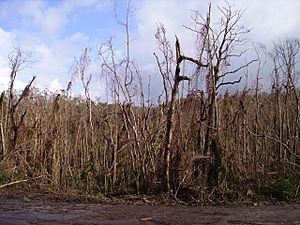
Tropical Cyclone Larry, an Australian Category 5 cyclone, struck the locality at 7am on 20 March 2006, with the eye of the storm passing over the town.
Severe structural damage occurred over the entirety of the township, the main damage being a portion of houses losing roofs and windows and the cyclone rendered even more homes structurally unsound. Power was effectively eliminated from the town and generators became a luxury in many homes. Clean drinking water was also compromised in many homes leading to health fears. The swift response of the Australian Defence Force was praised by many and the cleanup campaign they orchestrated allowed for total utilities restoration within 3 weeks. Severe damage was done to crops and plantations (mainly bananas) which had a serious economic impact on the region. Only one indirect death was record as a result of the cyclone.
Cyclone Larry was a direct and primary cause of the widely reported and dramatic surge in banana prices in Australia. Inflated cost remained until farmers were able to meet demand again in early 2007. In February 2011 Cyclone Yasi hit Innisfail.
In 2011, in the early morning of 3 February, Cyclone Yasi crossed the far north Queensland coast causing damage to the Innisfail area. Although the damage was not as severe as Cyclone Larry, Cyclone Yasi still had a huge impact on Innisfail bringing strong winds of possibly 285 kilometres per hour.
Innisfail today
At present Innisfail has largely recovered from the devastation of Cyclone Larry. After the cyclone the township underwent something of an economic boom that stemmed from an influx of tradespeople and business eager to capitalize upon relatively significant insurance payouts. According to reports local trade had increased some 30 - 40% opposed to expected increases of 10%.
The main industries remain predominately banana and sugar cane and have since recovered from the natural disaster. Outlying areas of Innisfail have also resumed manufacture of tea, pawpaws and other exotic fruits.
Innisfail remains a popular destination for backpackers seeking employment in the fruit picking industry. Tourism is of importance to the township and the town consistently seeks to attract visitors passing through on the Bruce Highway.
In Popular Culture
- Elizabeth Haran's 2003 novel Sunset over Eden is set in the town.
Economy
The main industries remain predominately banana and sugar cane. Outlying areas of Innisfail also grow tea, pawpaws and other exotic fruits.
Innisfail remains a popular destination for backpackers seeking employment in the fruit picking industry. Tourism is of importance to the township and the town consistently seeks to attract visitors passing through on the Bruce Highway. The town's Art Deco architecture is a drawcard for many tourists.
Education
Innisfail State School is a government primary (Prep-6) school for boys and girls at 7 Emily Street (17°31′06″S 146°01′41″E / 17.5183°S 146.0280°E). In 2018, the school had an enrolment of 165 students with 22 teachers (19 full-time equivalent) and 20 non-teaching staff (13 full-time equivalent). It includes a special education program known as Canecutters Cluster.
Good Counsel Primary School is a Catholic primary (Prep-6) school for boys and girls at 96 Rankin Street (17°31′16″S 146°01′44″E / 17.5212°S 146.0288°E). In 2018, the school had an enrolment of 279 students with 27 teachers (21 full-time equivalent) and 20 non-teaching staff (13 full-time equivalent).
Good Counsel College is a Catholic secondary (7-12) school for boys and girls at 66 Owen Street (17°31′15″S 146°01′43″E / 17.5207°S 146.0285°E). In 2018, the school had an enrolment of 371 students with 41 teachers (39 full-time equivalent) and 31 non-teaching staff (24 full-time equivalent).
There is no government secondary school within the locality of Innisfail, as the town's government secondary school, Innisfail State College, is located in Innisfail Estate immediately across the river east of the main town centre.
Notable residents
- Natarsha Williams, BMX rider, grew up in Innisfail. Natarsha was one of the first members of the Innisfail club and started racing BMX in 1981 at the age of 5 and had an extremely successful junior and senior BMX career that spanned 25 years. During her senior racing years she was given a lot of recognition in Europe and the USA particularly for her strength and jumping skills. Natarsha is the first Elite female to rack up a complete winning profile of 2 European Titles, 2 Pro girl Titles in the US, 3 World Cup Titles and 2 World Championships. Due to timing the only thing she missed doing was to compete in the Olympics. Natarsha was also the first Australian female rider to make the move to live in the US and make BMX a full-time career, she became the driving force for females at the time to develop their jumping skills and to improve female racing. Natarsha still lives in the US and is now the assistant cycling coach at the Marian University in Indianapolis.
- Scott Bolton, rugby league player for the North Queensland Cowboys, grew up in Innisfail. Bolton debuted with the Cowboys in 2007 and has spent his entire career with the club, winning a premiership in 2015.Barring injury, the 32-year-old Innisfail product and Cowboys life member will play his final game against the Storm in Melbourne in Round 25, 2019. Green said Bolton was one of a kind. "He’s one of those no-nonsense sort of blokes, he goes about his business, doesn't like too much fuss made of him," Green said. "He’s one of nine life members, he played his 200th game in 2017, he’s played 244 games for the club, played in two grand finals and will always be a premiership player too. "He came here out of school, so he's been a fantastic contributor over the years, and a big part of the legacy the club has left so far is down to guys like him."
- Kerry Boustead: former Queensland and Australian Rugby league great, Queensland's first ever try scorer in State of Origin rugby league. Kerry Boustead was also the only player from outside the Sydney and Brisbane Leagues selected to represent Australia on the 1978 Kangaroo tour.
- Jessica-Rose Clark, mixed martial artist currently signed to the UFC.
- Steve Corica: retired footballer who was capped numerous times for Australia and played in England, notably for Wolverhampton Wanderers, was also capped over 100 times for Marconi Stallions in the ex-NSL and Sydney FC in the A-League.
- Brent Cockbain former international rugby player (2003 World cup for Wales) grew up in Innisfail.
- Joseph Costa, BMX rider, grew up in Innisfail. Costa is a consistent BMX competitor.
- Ben Dunk,born 1987 Australia T20 and ODI cricket player
- Karl Gehringer, former Australian National and Commonwealth team Greco-Roman Wrestling 2005–2006, went to school in Innisfail. [1]
- Shannon McCann, Australian 100m Hurdler competed at the 2014 Commonwealth Games, grew up in Innisfail
- Billy Slater, rugby league player, grew up in Innisfail. Billy Slater played for the Melbourne Storm for sixteen seasons in the NRL and was an Australian International and Queensland State of Origin representative fullback. He played his whole NRL career at Melbourne and won four grand finals, two Clive Churchill Medals and the Dally M Medal with the Storm before his retirement from the sport in 2018. He has an autobiography and has been called the best fullback ever to have played the game by rugby league greats and fans alike
- Norman Stevens, Australian boxer at 1980 Moscow Olympics
- Ty Williams, former professional rugby league footballer for the North Queensland Cowboys and Queensland grew up in Innisfail. Williams returned to Innisfail to captain/coach the Innisfail Leprechauns in 2014.
Images for kids



